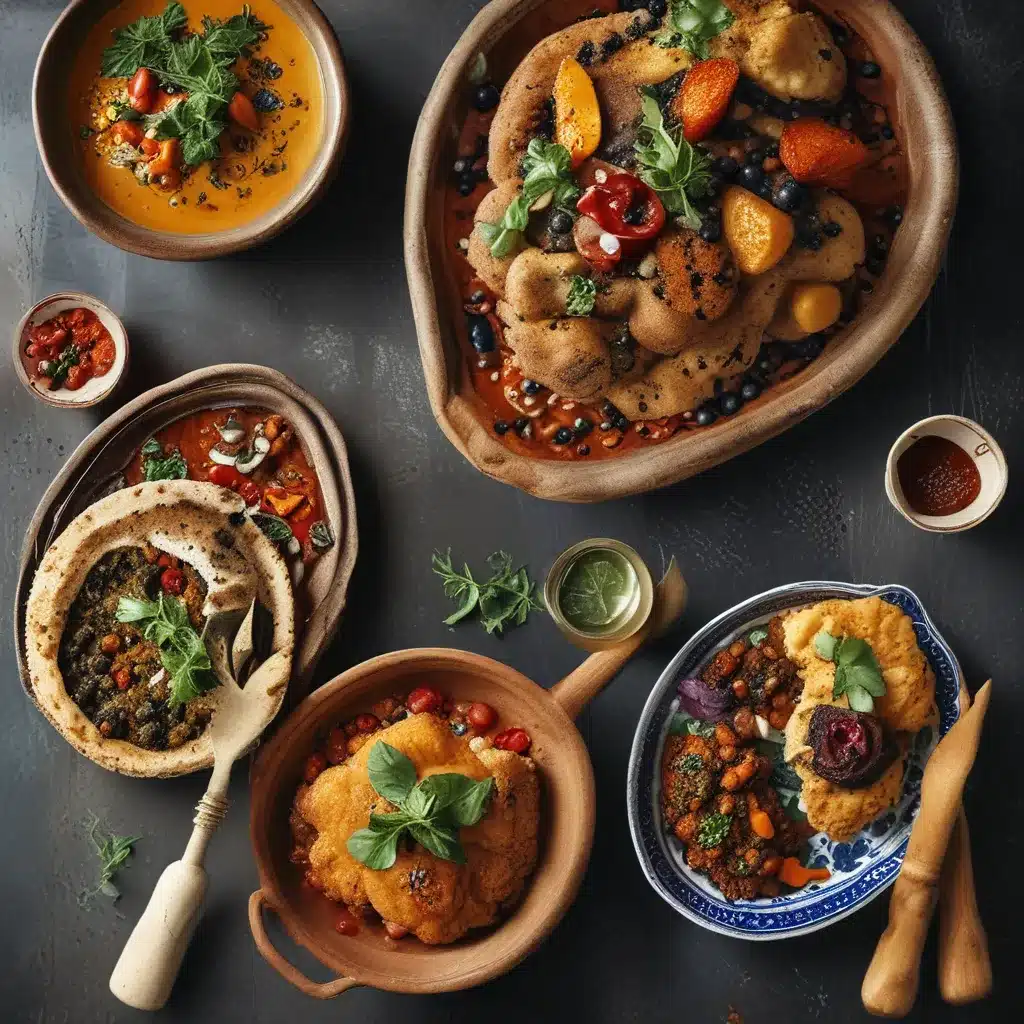
Discovering the Magic of Neo-Moroccan Cuisine
As I step through the doors of El Bahia, a renowned Moroccan restaurant in the heart of New York City, I’m instantly transported to a world of vibrant hues, captivating aromas, and unexpected flavor combinations. This isn’t your ordinary Moroccan eatery – it’s a culinary journey that celebrates the rich heritage of Moroccan cuisine while embracing the innovative spirit of modern cooking techniques.
The aroma of simmering spices and the sizzle of expertly seared meats greet me as I make my way to my table. I can’t help but feel a sense of anticipation, knowing that I’m about to embark on a gastronomic adventure unlike any other.
As I peruse the menu, I’m struck by the creativity and attention to detail that has gone into crafting each dish. This is no longer just tagines and couscous – this is Neo-Moroccan cuisine, a culinary movement that is redefining the boundaries of traditional Moroccan flavors.
Blending Tradition and Modernity
The founding chef of El Bahia, Driss Mellal, is a true visionary in the world of Moroccan cuisine. Drawing inspiration from his Moroccan heritage and his extensive culinary training, he has seamlessly woven together the rich tapestry of Moroccan culinary traditions with cutting-edge cooking techniques.
“Neo-Moroccan cuisine,” Driss explains, “is all about taking the familiar and transforming it into the extraordinary. We’re not just recreating classic dishes – we’re reimagining them with a modern twist, using the latest culinary innovations to bring out the best in every ingredient.”
As I dive into the menu, I’m immediately captivated by the vibrant colors and unexpected flavor profiles that jump out at me. The traditional tagine, a beloved Moroccan staple, has been reborn as a work of art, with tender, slow-cooked meats nestled in a bed of seasonal vegetables and saffron-infused broth. But the real showstopper is the presentation – the tagine is deconstructed, each element carefully arranged on the plate to create a stunning visual experience.
Embracing Seasonal Ingredients and Sustainable Practices
One of the hallmarks of Neo-Moroccan cuisine is its unwavering commitment to seasonality and sustainability. Driss and his team work closely with local purveyors and farmers to source the freshest, most vibrant ingredients available. They scour the bustling markets of New York, searching for the rarest spices, the ripest produce, and the most ethically sourced proteins.
“For us, it’s not just about creating a delicious meal – it’s about supporting our community and celebrating the incredible bounty that our region has to offer,” Driss explains. “We work tirelessly to ensure that every dish on our menu showcases the best of what’s in season, while also supporting sustainable farming practices and reducing our environmental impact.”
As I savor a delicate Pastilla variation, infused with the delicate floral notes of rose water and a surprisingly rich filling of caramelized onions and spiced lamb, I’m struck by the depth of flavor and the attention to detail that has gone into its creation. Each bite is a symphony of textures and aromas, transporting me to the bustling souks of Marrakech.
Pushing the Boundaries of Moroccan Cuisine
But Neo-Moroccan cuisine at El Bahia isn’t just about honoring tradition – it’s also about pushing the boundaries of what’s possible. Driss and his team are unafraid to experiment with cutting-edge cooking techniques, from sous vide to molecular gastronomy, all in the pursuit of elevating the dining experience.
Take, for example, the deconstructed tagine that I had earlier. The tender, fall-off-the-bone meat was achieved through the precise application of sous vide cooking, a method that allows for unparalleled control over temperature and doneness. The result is a level of textural perfection that simply can’t be achieved through traditional slow-cooking methods.
And then there’s the playful use of molecular gastronomy, where the chefs at El Bahia employ techniques like spherification and foams to create unexpected textures and presentations. I’m particularly enamored with the “eggshuka,” a modern take on the classic shakshuka that features a creamy, custard-like egg yolk nestled in a vibrant tomato and spice base – a true feast for the senses.
Elevating the Dining Experience
But Neo-Moroccan cuisine at El Bahia isn’t just about the food – it’s about the entire dining experience. The restaurant’s elegant, modern-yet-cozy atmosphere sets the stage for a truly immersive journey, with vibrant colors, intricate tile work, and subtle nods to Moroccan design elements.
As I savor each course, I’m struck by the attention to detail that permeates every aspect of the experience. The carefully curated cocktail program, featuring inventive twists on classic Moroccan flavors, sets the tone for the meal. And the impeccable service, with servers who are knowledgeable and passionate about the cuisine, ensures that I feel like a valued guest, not just a customer.
Celebrating the Essence of Morocco
Throughout my dining experience at El Bahia, I can’t help but feel that I’m not just enjoying a meal – I’m embarking on a cultural adventure. The flavors, the presentations, and the overall ambiance work in perfect harmony to transport me to the heart of Morocco, where the rich traditions of the past collide with the innovative spirit of the present.
As I savor the final bites of my dessert, a delicate rose-infused ice cream with crisp, golden choux puffs, I can’t help but feel a sense of wonder and excitement. This isn’t just a meal – it’s a celebration of the essence of Morocco, elevated and reimagined for the modern palate.
And as I step out into the bustling streets of New York, I know that I’ll be returning to El Bahia again and again, eager to discover the next chapter in this ongoing culinary odyssey.


